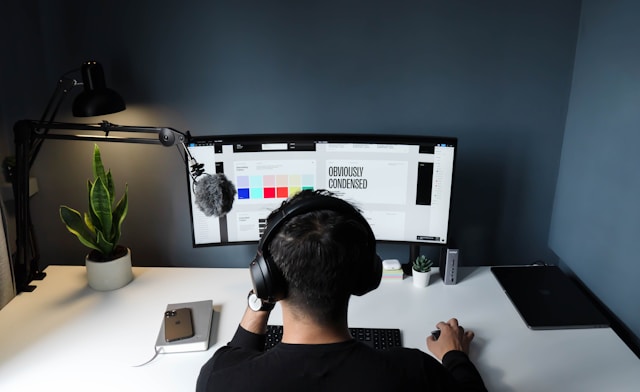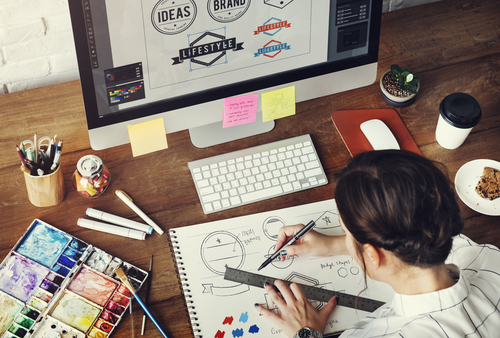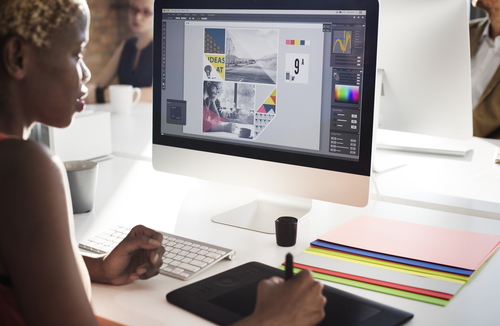Graphic design is the art of using visual elements such as typography, imagery, colour, shapes, and layout to communicate messages clearly and effectively. It merges creativity with technology to produce compelling content across various mediums, including print, digital, and multimedia. Whether it’s a company logo, a website interface, or an advertisement, graphic design enhances engagement and ensures clarity in conveying ideas.
The creative field of graphic design plays a vital role in modern branding, marketing, digital media and communication strategies. It is essential for modern business strategies, helping individuals and businesses to connect with and captivate their target audiences. Companies rely on graphic design for various purposes, including promoting and selling products through targeted advertising, simplifying complex information with infographics, and establishing a strong and cohesive brand identity. From marketing campaigns to user interfaces, graphic design shapes how a business presents itself and engages with its customers, making it an indispensable component of effective communication.

What Role Do Graphic Designers Play?
Graphic designers act as visual communicators, using their skills to shape perceptions, convey ideas, and engage diverse audiences. Their work is both purposeful and strategic, seamlessly blending artistic creativity with problem-solving to produce impactful, goal-oriented designs. By integrating creativity with strategic thinking, graphic designers craft compelling and meaningful visuals that resonate with viewers, enhancing overall communication. Their ability to merge artistry with functionality makes them indispensable across various industries, including advertising, publishing, web development, and corporate branding. Graphic designers develop visual concepts that inspire, inform, and captivate consumers, designing layouts and production assets for a wide range of applications such as advertisements, brochures, magazines, signage and reports. Each piece is carefully crafted to effectively communicate the intended message and resonate with the target audience. Through their creative expertise, graphic designers transform ideas into visually striking designs that capture attention and drive actions, fostering sales and building brand loyalty.
The Role of Graphic Design
Graphic design plays a vital role in both communication and branding by visually conveying messages, establishing brand identity, and fostering emotional connections with audiences through elements such as logos, typography, and imagery.
Building Brand Recognition and Identity Through
- Establishing a Visual Identity: Graphic design is essential in establishing a brand’s visual identity, shaping elements like the logo, colour palette, typography, and overall visual style.
- Visual Consistency: Graphic design ensures a consistent visual identity across all marketing channels, including websites, social media, print materials, signage and advertising, thereby reinforcing brand recognition.
- Memorable Logos and Imagery: Well-designed logos, colour palettes, and imagery create a memorable and recognizable brand that stays in the minds of consumers.
- Communicating Brand Values: Graphic design effectively conveys a brand’s personality, values, and message through visual elements, helping to foster a deeper connection with the target market.
Enhancing Marketing Campaigns
- Captivating Visuals: Eye-catching visuals in marketing materials, such as social media posts, email campaigns, and advertisements, capture attention and increase engagement.
- Improving User Experience: Well-designed websites and user interfaces enhance the user experience, making navigation intuitive and helping customers easily find what they need.
- Driving Conversions: Effective graphic design can significantly influence consumer behaviour, prompting desired actions such as making purchases or signing up for newsletters.
Influencing Consumer Perceptions
- First Impressions: A well-designed logo, website, or marketing material makes a strong first impression, conveying professionalism and establishing credibility.
- Building Trust and Loyalty: Consistent, high-quality design strengthens credibility and trust, cultivating customer loyalty and encouraging repeat business, ultimately turning customers into passionate brand advocates.
- Differentiating from Competitors: Distinctive and compelling design enables a brand to stand out in a saturated market, leaving a lasting and positive impression that differentiates it from the competition.
Visual Communication & Message Delivery
- Simplifying Communication: Graphic design translates abstract ideas and complex information into clear, visually engaging content, making messages easier to understand and more impactful.
- Evoking Emotions: Through the strategic use of colour, typography, and imagery, graphic design can elicit specific emotions and shape the overall brand experience, forging a deeper connection with the audience.
- Creating Visual Hierarchy: Designers strategically arrange elements to guide the viewer’s eye, ensuring that key information stands out and is absorbed quickly and effectively.
- Building Brand Recognition: Consistent use of visual elements such as colour, typography, and imagery across all platforms strengthens brand identity, making it easier for audiences to recognize and remember the brand.
Branding & Identity Creation
- Standing Out from Competitors: A strong and distinctive visual identity sets a brand apart in a competitive market, helping to create a memorable and unique brand image.
- Establishing Trust and Credibility: Consistent, high-quality design conveys professionalism and reliability, building trust and credibility with customers over time.
- Creating Memorable Experiences: Thoughtful graphic design leaves a lasting impression, helping to create engaging experiences that resonate with customers and strengthen brand loyalty.
- Communicating Brand Values: Visual elements such as colour, typography, and imagery convey a brand’s values and personality, allowing customers to connect with the brand on a more meaningful level.
Key Elements of Graphic Design
The key elements of graphic design include line, shape, colour, texture, space, imagery, typography, and scale (size), amongst others, which are the fundamental building blocks for creating visually effective designs.
Here’s a more detailed look at each element:
- Line: Lines – whether straight, curved, thick, thin, or dashed – are used to create structure, separate elements, and guide the viewer’s eye through a design.
- Shape: Shapes are defined by boundaries such as lines or colours and can be geometric (like squares and circles) or organic (like free-form and natural shapes). Each shape contributes to the overall meaning and visual impact of the design.
- Colour: Colour adds life and mood to a design. A solid understanding of colour theory encompassing the colour wheel, complementary colours, and colour harmony is vital for effective design. It encompasses the study of how colours interact and their psychological effects on viewers.
- Texture: Texture refers to the surface quality of a design element. It can be tactile (something you can physically touch) or visual (an illusion of texture on a flat surface), adding depth and realism to a composition. Incorporating texture adds depth and richness to the visual experience.
- Space: Space relates to the area around and between design elements. Effective use of space is crucial for achieving a balanced and readable design, allowing each component to stand out and enhance overall clarity, balance and legibility.
- Imagery: Imagery encompasses the use of images, illustrations, and icons to communicate messages and evoke desired emotions in the viewer. Thoughtful selection of imagery can significantly enhance the storytelling aspect of a design.
- Typography: Typography focuses on the selection and arrangement of fonts to create readable and visually appealing text. It encompasses the style, arrangement, and appearance of text within design concepts, directly influencing how information is perceived. It effectively describes the style, arrangement, and appearance of text used in design concepts.
- Scale (Size): Scale refers to the relative size of design elements, which can be manipulated to establish emphasis, hierarchy, and visual interest, thereby meaningfully guiding the viewer’s attention.
- Layout and Composition: The arrangement of elements within a design to create visually engaging and purposeful outcomes. An effective composition directs focus and enhances visual interaction.
- Branding and Identity: Graphic design plays a central role in creating and maintaining a consistent visual identity for businesses or individuals, encompassing logos, colours, fonts, and visual styles that represent a brand’s personality and values. This is essential for fostering brand recognition and loyalty.
Responsibilities of a Graphic Designer
- Developing visual concepts tailored to client requirements to meet specific objectives.
- Designing a variety of marketing materials, including logos, brochures, posters, websites, and social media graphics.
- Selecting colours, images, and typefaces that enhance the effectiveness and appeal of each design.
- Collaborating with marketing teams, web developers, and content creators to ensure cohesive and impactful messaging.
- Proficiently using design software such as Adobe Photoshop, Illustrator, and InDesign to bring ideas to life.
- Continuously enhancing skills, creativity and evolving trends by staying current with design trends and emerging technologies.
Types of Graphic Design
- Branding and Identity Design: Crafting logos, business cards, and other elements to establish a strong corporate identity.
- Marketing and Advertising Design: Creating promotional materials such as posters, flyers, and social media graphics that capture attention and encourage buyer engagement.
- User Interface (UI) Design: Improving the usability and aesthetics of digital products like websites and mobile apps to ensure an optimal user experience.
- Publication Design: Designing visually compelling layouts for magazines, books, and newspapers to attract and retain reader interest.
- Web Design: Designing user interfaces (UIs) and user experiences (UXs) for websites and applications.
- Motion Graphics and Animation: Producing animated visuals for video content, advertisements, and entertainment that enhance storytelling and engagement.
- Packaging Design: Developing eye-catching packaging solutions that not only protect products on retail shelves but also influence consumer purchasing decisions.
- Illustration: Creating visual content through drawings and paintings.
Conclusion
Graphic design is an essential tool used by businesses and individuals to differentiate themselves and stand out in a competitive marketplace. Thoughtfully designed visuals not only attract and hold customer attention but also establish a strong brand identity and convey professionalism. As such, graphic design is more than just aesthetics. It serves as a strategic communication tool that shapes how audiences perceive a brand or message.
Professional graphic designers are essential in shaping the visual identity of businesses and individuals, ensuring their messages are not only tangibly captivating but also connect meaningfully with their target audience.

